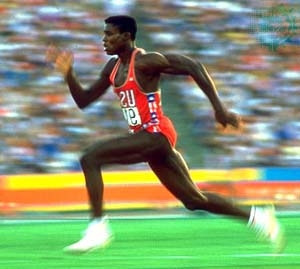The basic elements of "proper" arm action are as follows:
- the shoulders are square and remain relaxed while the arm is able to swing freely (like a pendulum)
- the arm is bent at 90 degrees (as coach Danaka Porter says "Keep it in an L-shape") on both upswing and downswing
- the downswing takes the hand past your waistband (my youth coach used to refer to sweeping past the top of your tracksuit pockets)
- the upswing takes your hand to just below eye level (check out the image of Carl Lewis below)

Here is a simple drill that I recommend athletes do in front of a mirror to observe their own arm action (amazing what some visual feedback can do to refine technique):
Once you have used the visual feedback to refine the arm action, you will need to spend time doing the arm action to become comfortable with it. The seated arm action is an excellent drill that an athlete can do while watching TV (commercial breaks are a good length of time to get some arm action reps done). Here is a video of this drill:
For some more advanced observations, my friend Jimson Lee has an excellent article on arm action on his blog. He likes to quote famous Canadian Track Coach Geoff Gowan , “You run with your arms on your legs”.

